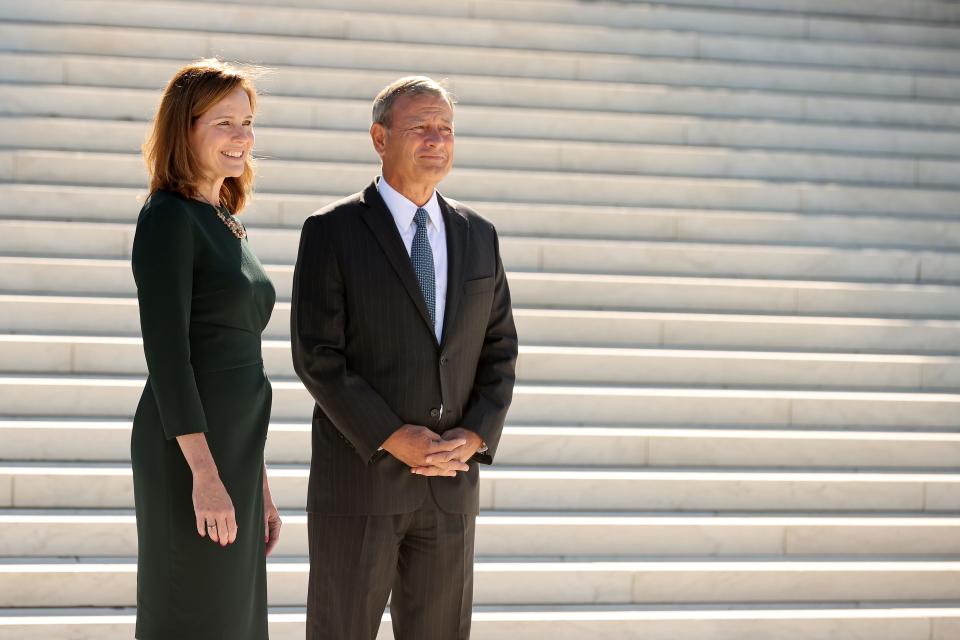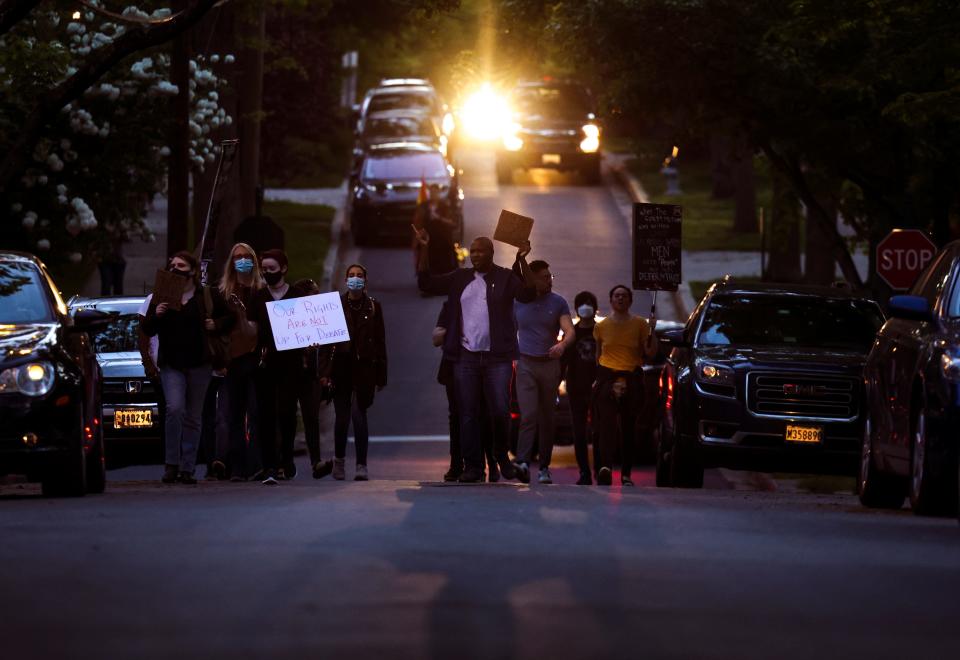Chief Justice John Roberts facing test of leadership amid tense time at Supreme Court
- Oops!Something went wrong.Please try again later.
- Oops!Something went wrong.Please try again later.
- Oops!Something went wrong.Please try again later.
- Oops!Something went wrong.Please try again later.
WASHINGTON – Chief Justice John Roberts had a consistent message at his confirmation hearing 17 years ago: His approach, he said then, would be one of restraint and stability at the Supreme Court.
"Given my view of the role of a judge, which focuses on the appropriate modesty and humility, the notion of dramatic departures is not one that I would hold out much hope for," Roberts said at his 2005 hearing when asked if he thought the court's methods would vary from that of his predecessor, Chief Justice William Rehnquist.
With a bevy of hugely divisive issues such as abortion and guns on the docket, an active investigation into the unprecedented leak of a draft opinion in one of those cases and internal criticism of the court's culture bursting into view, Roberts' grip on the high court and his strategy of seeking middle ground is being tested like never before.
Once a swing vote, Roberts lost power when Associate Justice Amy Coney Barrett was seated in 2020. President Donald Trump's final nominee gave conservatives a 6-3 advantage for the first time in decades, meaning Roberts could no longer build a majority by joining either the liberal or the conservative wing.
"This does seem to be a turning point," said Keith Werhan, a professor at Tulane University Law School. "We've seen maybe the waning of Chief Justice Roberts' influence but more than that we’ll be seeing this five-justice group defining themselves."
RBG: Abortion brawl draws Ginsburg's legacy on Roe v. Wade into the spotlight
History: Justice Alito's leaked draft animates debate over history of abortion
Farms: How a Supreme Court case about pig farms could muddy abortion debate
The leaked opinion in Mississippi’s challenge to Roe v. Wade last month underscored the point: Politico reported that five justices supported overturning Roe, the landmark 1973 opinion that established a constitutional right to abortion. CNN reported that Roberts was not one of the five supporting the draft, written by Associate Justice Samuel Alito, and was instead seeking a less dramatic outcome.
A more narrow decision is still possible. Roberts might convince Associate Justice Brett Kavanaugh or Barrett to uphold Mississippi’s ban on most abortions after 15 weeks of pregnancy but leave Roe's central holding in place. The chief justice appears to have pulled off a similar hat trick last year, resulting in a unanimous opinion that allowed a Catholic foster care agency in Philadelphia to turn away LGBTQ couples as clients but kept the scope of the decision narrower than some conservatives had sought.
Notably, the court declined in that decision to overturn a controversial precedent from 1990 that controls when governments may impose restrictions on religion.

"It is certainly the case that justices have changed their mind after their initial votes," said Neal Devins, a law professor at William & Mary Law School. "With that said, the fallout from the leak has personally affected the justices in ways…that might make them hesitate to defer a decision" or to change their votes.
Devins predicted Alito's majority will probably hold but warned no one knows for sure.
"It ain't over until it's over," he said.
It's not only the abortion case that has drawn attention to Roberts' management of court but also the leak itself. Speaking at an event in Dallas last month, Associate Justice Clarence Thomas lamented the breach of trust he said the leak caused. He also suggested the discord among the nine justices runs deeper than the most recent leak – that something had been lost since he joined the Rehnquist court in 1991.
"We may have been dysfunctional family, but we were a family. And we loved it," Thomas said, relying on the past tense in his remarks. "I mean, you trusted each other. You would laugh together. You went to lunch together every day."
Explainer: What to know about John Roberts, chief justice of the United States
Graphic: What did Roe v. Wade say? The landmark abortion rights ruling, explained
LGBTQ: Court to decide if businesses may decline same-sex wedding services
And more recently there are signs of internal strife caused by the leak beyond the justices. The court’s law clerks – the top law school graduates that are often the first to have a finger pointed at them when there is a breach of secrecy at the court – have been asked to provide cell phone records and sign affidavits, CNN reported.
At least some of them are considering hiring attorneys of their own.
The court, meanwhile, is behind pace for releasing opinions. Last year at this time, it had decided 63% of its outstanding cases. This year, the court has cleared about half of its caseload. The court generally finishes its work by the end of June. To meet that target this year, it will have to hand down nearly eight opinions a week, on average.

The outstanding cases involve some of the most divisive issues the justices have encountered in years. In addition to abortion, the court is considering a Second Amendment lawsuit that could expand the right to carry handguns at a time when the nation is once again plagued by a series of mass shootings, including one at a Texas elementary school in which 19 children and two teachers were killed.
It also will hand down decisions about the government's ability to address climate change, religious freedom and President Joe Biden's immigration policies.
Polls indicate public approval of the Supreme Court fell sharply after the leaked draft opinion. About 44% of Americans approve of the way the nation's highest court is handling its job, down 10 points from March, a Marquette Law School poll showed. That decline was driven mostly by Democrats and independents. Approval rose slightly among Republicans, who are more likely to embrace anti-abortion positions.
For conservatives, it was Roe that was wrongly decided, divorced from the text of the Constitution. Far from politicizing the court, anti-abortion groups and some of the court's conservative justices – including Alito, according to the draft – believe the 1973 decision is largely responsible for many Americans viewing the court as a political institution.
Nominated to the Supreme Court in 2005 by President George W. Bush, Roberts – a former Rehnquist clerk – is difficult to pin down. Conservatives fumed when he sided with liberals in the case upholding the Affordable Care Act in 2012. Liberals never forgave him for joining conservatives in 2013 to strike a provision of the 1965 Voting Rights Act requiring some states to get federal approval for new voting laws.

As a lawyer in President George H.W. Bush’s administration, Roberts, 67, represented an administration that not only opposed abortion but believed Roe was wrongly decided. Roberts' wife, Jane Roberts, supported anti-abortion groups before he was confirmed. But as chief justice, Roberts must think about the high court's institutional stability – and the erosion of trust if the court appears to be veering into politics.
That partly explains why Roberts joined the court's liberal wing in 2020 to strike down a Louisiana law requiring doctors who perform abortions to have admitting privileges at nearby hospitals, even though he supported those same state restrictions four years earlier – voting to uphold a Texas law on admitting privileges. Critics saw a flip-flop. Roberts asserted he was respecting the court's earlier decision.
The court's focus on honoring precedent, he wrote, "requires us, absent special circumstances, to treat like cases alike." Because the Louisiana law imposed a burden on access to abortion "just as severe as that imposed by the Texas law," he wrote, "Louisiana’s law cannot stand under our precedents."
Part of Roberts' responsibility now, Werhan said, is to rebuild.
"There obviously is a breakdown in the cultural mores on the court," he said. "Rather than being retributive in going after the leaker, my inclination would be to be more positively focused and try to reconstruct mutual respect and confidence on the court."
This article originally appeared on USA TODAY: Leaked abortion draft tests John Roberts' grip on Supreme Court

